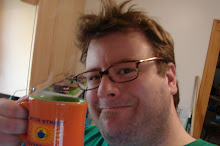- That box of bullshit from Globo-chem's pancake division
- 2 cups bread flour
- 2 tbs sugar
- 1/2 tsp table salt
- 1 tsp baking powder
- 1/2 tsp baking soda
- 1/2 cup shredded sweetened coconut
- 1/2 cup bittersweet chocolate chips (I use Ghirardelli)
- 2 cups buttermilk
- 1/4 cup sour cream
- 2 eggs
- 3 tbs unsalted butter, melted & cooled
 Step two: throw that box of imitation pancake bullshit in the trash.
Step two: throw that box of imitation pancake bullshit in the trash. Put on some pancake making music. Hotcakes by Gas Huffer, or either of the first two albums by Presidents of the United States of America.
Put on some pancake making music. Hotcakes by Gas Huffer, or either of the first two albums by Presidents of the United States of America. Get yourself two medium to large mixing bowls. When you make pancakes, it's important to keep the dry and wet ingredients separated in the beginning so that you don't over-mix the batter. Mixing wet flour develops gluten, and we want to keep that to a minimum.
 Put the wet ingredients in the other bowl, making sure to cool the butter before it goes in. Put in hot butter, and you're not getting pancakes, you're getting effed-up scrambled eggs. Whisk the wet together, and then pour into the dry.
Put the wet ingredients in the other bowl, making sure to cool the butter before it goes in. Put in hot butter, and you're not getting pancakes, you're getting effed-up scrambled eggs. Whisk the wet together, and then pour into the dry. Get your silicon spatula and fold the whole mess together. Don't go nuts here. Don't beat the christ out of it with a whisk. Just fold it together enough times that the flour is entirely wet. Lumps are good. Lumps are good.
Get your silicon spatula and fold the whole mess together. Don't go nuts here. Don't beat the christ out of it with a whisk. Just fold it together enough times that the flour is entirely wet. Lumps are good. Lumps are good.Let the batter sit for 10 minutes. Go make yourself some coffee.
 A word on cooking surface choice. When I make pancakes, I use a cast iron griddle. Cast iron has excellent heat retention, which means it cooks evenly and won't lose much heat when you drop a big, room-temperature blob of pancake batter on it. If you're using a non-stick frying pan, you're going to need to set the burner slightly higher than the medium-low I use in this recipe. Warm up whatever you're using, and pour on a teaspoon or two of vegetable oil. When it shimmers, wipe the pan with a paper towel to spread the oil and remove the excess.
A word on cooking surface choice. When I make pancakes, I use a cast iron griddle. Cast iron has excellent heat retention, which means it cooks evenly and won't lose much heat when you drop a big, room-temperature blob of pancake batter on it. If you're using a non-stick frying pan, you're going to need to set the burner slightly higher than the medium-low I use in this recipe. Warm up whatever you're using, and pour on a teaspoon or two of vegetable oil. When it shimmers, wipe the pan with a paper towel to spread the oil and remove the excess.To pour the batter on the griddle, I use a large serving spoon and the silicon spatula. This batter is quite a bit thicker than your standard pancake batter, so once you drop it on the griddle, you're going to need to spread it out with the spatula. There's something of a learning curve here, but keep at it and you'll figure it out. It's sort of like making a crepe, only thick instead of runny.
 After you've got it spread out, let it cook. These cakes will get much thicker than your average factory-cake. You'll know it's time to flip when bubbles pop on the top, around halfway between the center and the edge and don't immediately smooth back out again.
After you've got it spread out, let it cook. These cakes will get much thicker than your average factory-cake. You'll know it's time to flip when bubbles pop on the top, around halfway between the center and the edge and don't immediately smooth back out again.  I like to use a pretty flexible spatula for this. Run your spatula around the edge of the pancake so that it slides freely on the griddle, and then flip it over. Cook the other side until it's nice and brown. Remember, brown=sugar caramelization=flavor.
I like to use a pretty flexible spatula for this. Run your spatula around the edge of the pancake so that it slides freely on the griddle, and then flip it over. Cook the other side until it's nice and brown. Remember, brown=sugar caramelization=flavor. Maple syrup is probably a little much to go on top of coconut & chocolate chip pancakes, but I do like to hit this with a little confectioner's sugar or whipped cream. This recipe will make about six big-assed pancakes. One is plenty for most people.
Maple syrup is probably a little much to go on top of coconut & chocolate chip pancakes, but I do like to hit this with a little confectioner's sugar or whipped cream. This recipe will make about six big-assed pancakes. One is plenty for most people.
